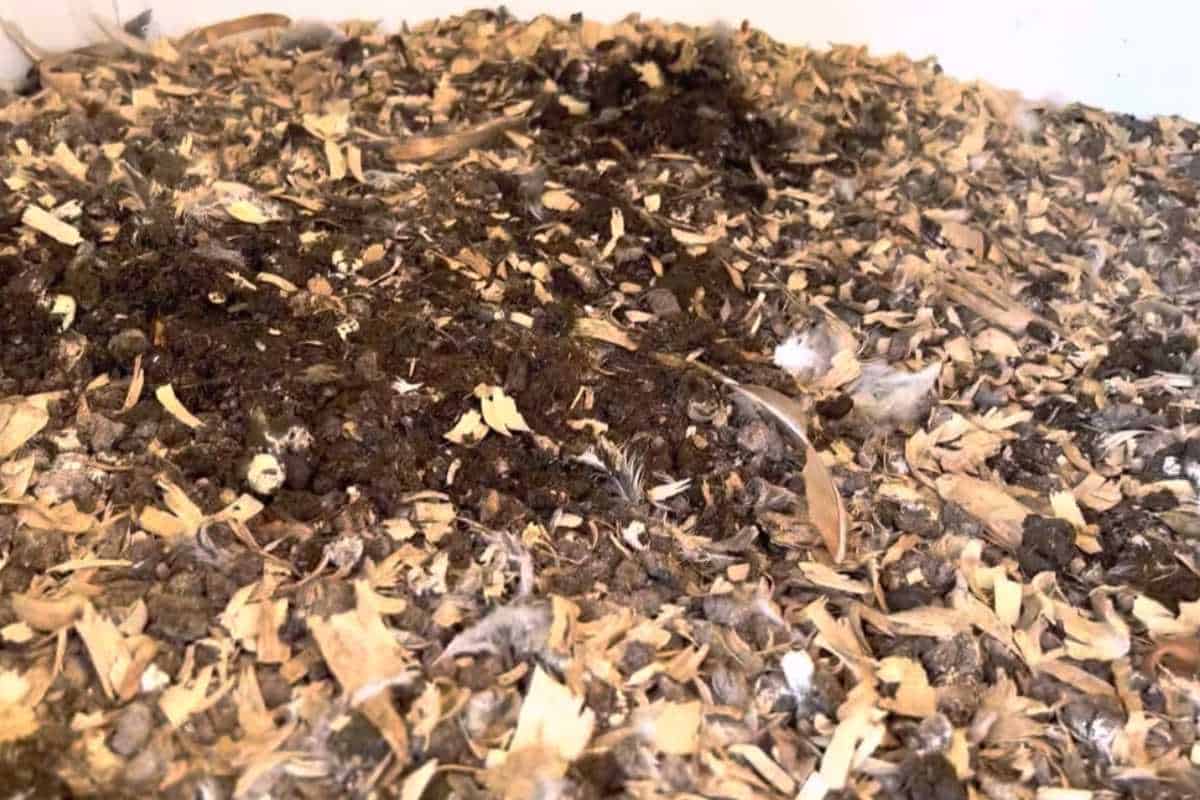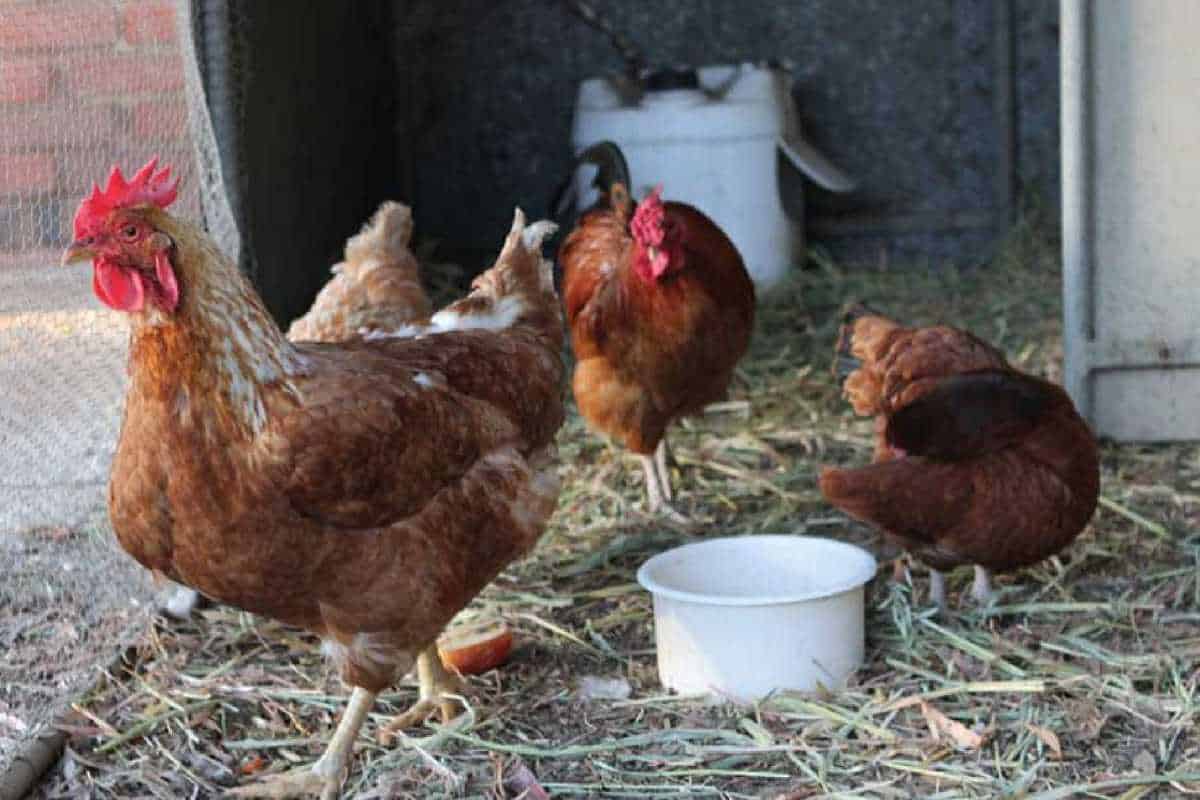This chicken coop deep litter method guide will give you all the information you need to build your own deep litter, including its maintenance and cleaning procedures. We will also help you identify the possible issues in your deep litter and how you can resolve them. But before any of that, let us learn first what the deep litter method is and how it works!
What is the Deep Litter Method?
The Deep Litter Method is a popular and efficient technique to compost chicken litter. This method was first used by Ohio Station Brooder House back in 1946 for better sanitation and health care of chickens. Deep litter was initially called Built-Up Litter.
As poultry farmers, we can experience various problems in our backyard. One of these is the unimaginable amount of waste our flock produces daily and its unpleasant odor. Although these issues are out of our control, we can take advantage and turn these feces into helpful fertilizers by composting them.
Turning chicken droppings with carbon-based materials, like leaves and pine shavings, into a nitrogen-filled fertilizer using the deep litter system is easy. This deep litter system may also regulate coop temperature, especially during winter.
How does the Deep Litter Method work?

So, you may be wondering how the deep litter method works. Does it really help compost the chicken droppings? Let’s dig into that!
Basically, deep litter is a 6-inch bedding for chickens made from carbon-based materials. These materials absorb the nitrogen and moisture from the chicken droppings.
The deep litter method is about controlling moisture and ventilation. To ensure adequate oxygenation, the owner should stir the bedding daily. Meanwhile, the flock may also scratch these beddings to make way for oxygen and help decompose the mixture much faster.
This system requires the addition of carbon-based layers to maintain cleanliness and prevent excessive dampness. With each addition of layers, the bedding will build up to 12 inches, and the bottom part will become dry compost.
Advantages and Disadvantages of the Deep Litter Method
Implementing the Deep Litter Method is like hitting many birds with one stone! It saves you time cleaning the coop while helping you give the best care for the flock by making vitamins B12 and B2 easily accessible. In deep litter, the birds are also protected and safe.
It also aids the economic aspect of the owners by reducing labor costs since you will not need to clean the coop daily. The budget for materials will also be minimized; carbon-based materials are usually affordable and accessible. Most of all, the deep litter system will result in a nitrogen-rich compost that you can freely use in your garden or farm.
However, like all systems used in poultry farming, the deep litter system also has its own disadvantages. One of the known disadvantages is its effect on the chickens’ health. Since the litter has physical contact with the flock, they are much more prone to respiratory diseases, bacteria, and parasites.
| Advantages | Disadvantages |
|---|---|
| 1. Provides warmth: Acts as insulation during colder months. | 1. Risk of ammonia buildup if not turned regularly. |
| 2. Reduces cleaning frequency: Less frequent coop cleanouts. | 2. Potential for pathogen buildup if not managed properly. |
| 3. Natural composting: Creates rich compost over time. | 3. Can attract pests like mites or rodents. |
| 4. Can reduce feed costs: Chickens eat beneficial bugs. | 4. Requires periodic addition of new bedding. |
| 5. Helps in controlling odor when maintained. | 5. Moisture management is crucial to prevent mold and fungi. |
Preparation for Deep Litter

Preparing for a deep litter system is very challenging because you must gather all the needed materials. Criteria for a successful deep litter should also be taken into consideration.
Here are the Materials & criteria to meet for a successful deep litter setup:
Bedding materials
The bedding materials used for a deep litter are a crucial factor that will either make your system work or not. Each carbon-based material has different effects on the flock, which can affect the deep litter’s overall success.
The best option for the base layer of the deep litter system is wood, like pine shavings. Wood materials could adequately absorb the moisture from chicken poop and will not cause a foul odor to the coop. Prevent utilizing non-absorbent layers like straw and sawdust.
Land Space
Depending on the age of the chicken, each of them has different requirements in terms of land space when placed in a deep litter system. For example, a one and two-week-old chick must be allotted a floor space of 0.2 Sq.ft., and a nine-week-old chick should have a 0.9 sq. ft. floor space.
Understanding the land space requirement of each chicken will help you allocate the accurate land size for them. This will also prevent you from having an overcrowded litter system, resulting in an unbalanced droppings and bedding ratio.
Flock Diet & Nutrition
The nutritional needs of chickens in a regular coop differ from those in a deep litter system. Ensure to give the latter feeds that will help boost energy as they will need it since they are much exposed to scratching the ground, running, and perching.
Ventilation
Lastly, prepare a coop with an excellent ventilation system. This will help in the oxidation of the chicken droppings, which results in faster decomposition. Enough ventilation will also prevent your chickens from having heat stress.
5 Steps to Implementing the Deep Litter Method

Now that you know the needed materials and criteria for a deep litter system, let us proceed to the most critical part of this blog! How do you implement a deep litter system?
Step 1. Prepare the area and materials
Decide on what carbon-based material you will use for the bedding. Also, ensure that the area where you place the deep litter suits the criteria for a successful system. The site should be spacious enough for the number of chickens you have, and the ventilation system should also be a priority.
Deep litter is often placed in concrete flooring, but the ideal one to set it up is on earth floors because it can absorb the chicken droppings well. Minimize using wooden floors since the moisture can cause rot and a bad smell.
Step 2. Spread the first layer of bedding
In the chosen area, scatter 4 to 6 inches of bedding material. Ensure it is flat and all sides are covered. Most of all, the materials should be super-absorbent.
Step 3. Let the chicken make droppings
Once the chicken starts pooping in the deep litter, stir the bedding occasionally. Adding another layer of carbon-based material is also necessary until it reaches 12 inches deep.
Step 4. Clean the deep litter and start anew
If the deep litter has already reached 12 inches, remove the bottom part of the bedding as it decomposed. After removing, keep adding more materials on top.
Usually, changing to a new deep litter system happens twice a year. During this, keep a few inches of decomposed bedding from the bottom to help decompose the new materials.
Expert tip: Scatter treats on the bedding to encourage scratching and pecking of the flock. These actions will help oxygen to enter.
Proper Maintenance and Composting Tips
- Controlling the moisture of the compost is crucial. When testing for moisture, grab a handful of the mixture and squeeze it; if no water is dripping, the deep litter is in good condition.
- Be mindful of the smell inside and in the surrounding area of the deep litter system.
- Remember to turn and stir the deep litter.
- Adding more chickens than the deep litter system can handle is not preferable. There is a ratio to be followed.
- The deep litter system will require more patience. Do not add new bedding when unnecessary, only to speed up the process.
- Feel free to use larger flakes of materials instead of finer ones to avoid clumps.
Common Mistakes to Avoid
- Using diatomaceous earth to control mites and pests in the coop. This will only kill the microorganisms you need for a successful deep litter.
- Being complacent in maintaining the deep litter system. One misconception about deep litter is that it doesn’t need much upkeep; instead, it can be left alone for an extended period.
- Not providing enough ventilation.
- Placing the deep litter system near water supplies and leakages.
- Limiting the number of feeders and drinkers in the coop. Placing as many as possible in different areas is ideal, especially if your deep litter is wide where chickens freely roam.
When and How to Add More Litter

Typically, adding new clean litter happens every week or every two weeks. Since chickens release their droppings every day, the tendency of the bedding to become wet is high. Adding new litter will lessen the possibility of moisture building up in the bedding materials.
Moreover, you need to turn the bedding every day. It will help in oxidation and will speed up the composting process.
So, how do you add more litter? Well, all you need to do is to spread a few centimeters of new litter to the top of the previous bedding. Please do not remove the bottom of the composted part unless it is ready. After the clean litter, you may also add pest control materials on top.
When and How to Clean Out the Coop
The deep litter system will lessen hard chores in your coop, especially cleaning the chicken droppings. However, you must know that cleaning it must be done diligently and promptly. It requires consistency and patience.
You can clean the coop’s deep litter 2 to 3 times a year. But, most poultry farmers only clean them twice a year. Usually, the deep litter is scooped out of the coop at the end of the winter season to pave the way for a new litter.
Speaking of fresh litter, use a shovel to scoop the dirty litter; using a wheelbarrow is also helpful for a much more efficient cleaning process. Then, transfer it to your composting site. One thing to remember is to still leave some litter in the coop because it will help compost the new layers of bedding you will add.
Troubleshooting Issues in Deep Litter

Understanding deep litter is one thing, but knowing the indications of a failed deep litter system will help you a lot more than you imagine. Here are 3 possible issues with deep litter that you may encounter and their solutions!
Salmonella Infection
According to research from the Mayo Clinic, Salmonella Infection or Salmonellosis is a kind of bacterial infection that affects an animal’s or human’s intestinal tract. This can be contracted through stools or feces– where chickens in the deep litter system are exposed to.
In order to avoid contamination in the coop, poultry farmers should be vigilant. Check each chicken before putting them in the deep litter; this will prevent rapid exposure for other healthy chickens. Meanwhile, when Salmonella infection is already prevalent in the coop, separate the infected chickens and take the necessary measures to treat them.
Ammonia Smell
It is necessary to observe the ammonia smell in the coop. This happens when the bedding becomes too wet due to an unequal ratio of clean litter and chicken droppings. The ammonia smell is pungent and easily detectable when you pay attention to the odor in the deep litter.
To prevent the ammonia smell, regularly clean and stir the bedding. Adding new layers of carbon-based materials at the respective time will also help.
Mold growth
Like the Ammonia smell, mold growth is another possible issue in the deep litter due to the dampness of the bedding. Prevent this by using earth base materials in your enclosure instead of wood. Keep the bedding as dry as possible; most importantly, avoid placing the deep litter near bodies of water or other moisture sources.
Conclusion
We hope this chicken coop deep litter method guide helped you understand what deep litter is and its pros and cons. As well as the things you should not do, the proper maintenance, and the issues you might encounter. But, more than anything, we hope you learned how to set up your own backyard deep litter for your flock!


Joseph Hudson has been raising chickens for over 15 years. In 2018, he completed the Agriculture & Natural Resources program at Mt. San Antonio College. He currently raises over 1400 chickens on his 7.5-hectare farm. He keeps sharing his experience on raising healthy and happy chickens on Chicken Scratch The Foundry.







